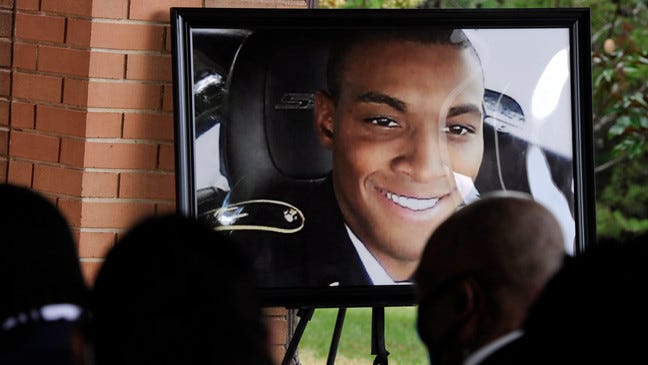Hey Survivors,
Welcome back to The Den, one of the last safe spaces in this wild apocalypse we call life. If you’re new here, we talk horror, apocalyptic fiction, and of course… zombies. I hope you’re surviving (and thriving) on your side of the wasteland.
Now, the Summer of Screams is still going strong, but today I’ve got something special for you. My latest novel, Camp Lanier, just won a literary award from the BCALA! That’s the Black Caucus of the American Library Association, which is an incredible honor.
To celebrate, I'd like to take you behind the scenes and show you the real-life events that inspired this horror story. Camp Lanier is one of my favorite books I’ve written, not just because I got to mix slasher fun with supernatural horror but because it allowed me to shine a light on real issues, tragedies, and buried truths that deserve our screams.
Let’s get into it.
Warning: This may contain minor spoilers for Camp Lanier and graphic language about real crimes and deaths throughout the years.
Subject Matter:
Murder
Sexual Assualt
Police Burtilry
Abuse Against Children and Women
Missing people
I was in Philadelphia to accept the award, and I’m not gonna lie, I was shook. I stood in that room full of incredible authors and thought, Do I even belong here? But when they called my name, and I walked onstage, I knew I did. Writing is my purpose. If I can use it to entertain, to inform, to make people feel something, I’m on the right path. And this was a sign to keep going.
Grab your award-winning copy of Camp Lanier here:
The Oklahoma Girl Scout Murders (1977)
This case has haunted me since college. My friend Ashley once told us her mom knew someone tied to an episode of Unsolved Mysteries, and then she shared the story of the Oklahoma Girl Scout Murders, one of the darkest things I’d ever heard.
On June 13, 1977, three young Girl Scouts, Lori Farmer (8), Michele Guse (9), and Doris Milner (10) were sexually assaulted and murdered at Camp Scott in Mayes County, Oklahoma. Their bodies were found just yards from their tent. Gene Leroy Hart, an escaped convict with a history of violence, was arrested but later acquitted. DNA evidence decades later pointed back to Hart, but justice was never officially served.
What shook me most? Before camp started, someone sent a threatening letter to the camp saying people would be murdered. Staff dismissed it as a prank. That oversight cost lives. I pulled that directly into Camp Lanier: the willful ignorance, the choice to ignore danger to protect a business. In my story, the three ghost girls chasing Taylor are a direct nod to these victims, and a reminder of what happens when warnings go unheeded.
Oscarville and Lake Lanier
Oscarville is the emotional core of Camp Lanier. Once a thriving Black town in Forsyth County, Georgia, Oscarville was violently erased in the early 1900s through racial terrorism, and the land was later flooded to create Lake Lanier. In this very real, very cursed lake, 20 people die each year.
This isn’t fiction. This is history that people are still trying to hide. I once submitted Camp Lanier to a horror event near the lake, and the venue rejected it, because they didn’t want to "associate" with the lake’s history or its body count in 2024.
Lake Lanier isn’t alone. Central Park, Tulsa, Lake Martin, and others were all once Black communities stolen or destroyed and buried, sometimes literally, under concrete and water.
We have to scream these stories. Loudly. Justice begins with the truth.
The Atlanta Ripper (1911–1915)
Some readers think I made the Atlanta Ripper up, but he was very real.
From 1911 to 1915, at least 20 Black women were murdered in Atlanta. The killings were brutal, consistent, and largely ignored by the white press. It wasn’t until Black workers began staying home out of fear, and white businesses started losing money, that police and newspapers paid attention. No one was ever arrested. No one was held accountable.
The Ripper in Camp Lanier is based on this true killer. I changed his appearance, but the story Jason tells Taylor? That’s fact. He was Atlanta’s first boogeyman, and history forgot him, so I made sure horror didn’t.
The Kids for Cash Scandal
In the early 2000s, two Pennsylvania judges were caught sending over 3,000 kids to juvenile detention centers in exchange for kickbacks from private prison contractors. One child was jailed for mocking her principal on Myspace.
This case made me look at the justice system even more sideways. In Camp Lanier, Taylor gets to choose between jail or a work-release program. At first glance, it’s a Holes-style setup. But I asked: What if the judge knew exactly what was going on at the camp? What if it wasn’t a mistake, but a profit-driven scheme?
Missing Black Children & "Runaway" Labels
You’ve probably heard of the Missing White Woman Syndrome (MWWS), how white women’s disappearances receive massive media attention while Black and Brown cases go ignored.
When Gabby Petito went missing in 2021, her case made national headlines. Meanwhile, dozens of Black girls and Indigenous women were also missing and barely mentioned. That disparity inspired the story logic of Camp Lanier.
In real life, police often label missing Black or Brown kids as runaways, effectively closing the case before it starts. That label is used in the book, too. Kids vanish from Camp Lanier, and nobody looks, because they were “at-risk youth.” People assume they ran away. It’s easier than caring.
It happens every day. And in the book, those missing kids become ghosts of the ignored.
The Police Shooting of Damian Daniels
This one is personal.
In 2020, my battle buddy Damian Daniels was shot and killed by police during a wellness check. He was a soldier, a good man, and a friend. After the military, life got harder. Mental health battles crept in. His family called for help, hoping he’d be taken to a hospital. Instead, he was surrounded, tackled, and shot. I found out through Instagram. I saw his photo and thought it was good news.
It wasn’t.
I added that scene to Camp Lanier, not for drama but to process grief. To scream into the void. To make sure his story, his pain, wasn’t forgotten.
Rest easy, Battle. This world didn’t deserve you.
Want more behind the scenes?
If you liked this breakdown and want more deep dives into the real-life horror behind the fiction, let me know. Email me, leave a comment, or hit me up on social media. And if you haven’t read Camp Lanier yet, there’s no better time than now.
Grab your copy of Camp Lanier
As always…
Stay safe. Stay woke. Stay alive.
Until the next nightmare,
—Sylvester
Author of Planet Dead and More.












